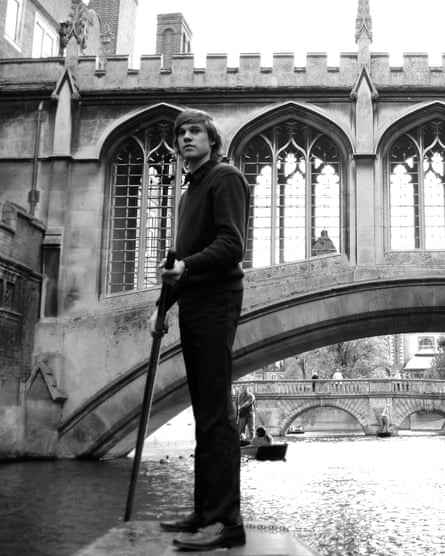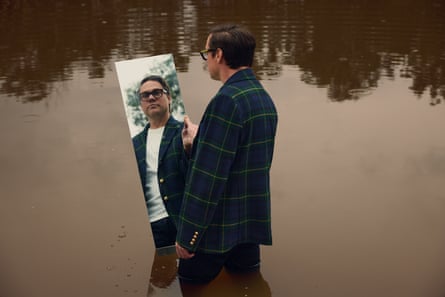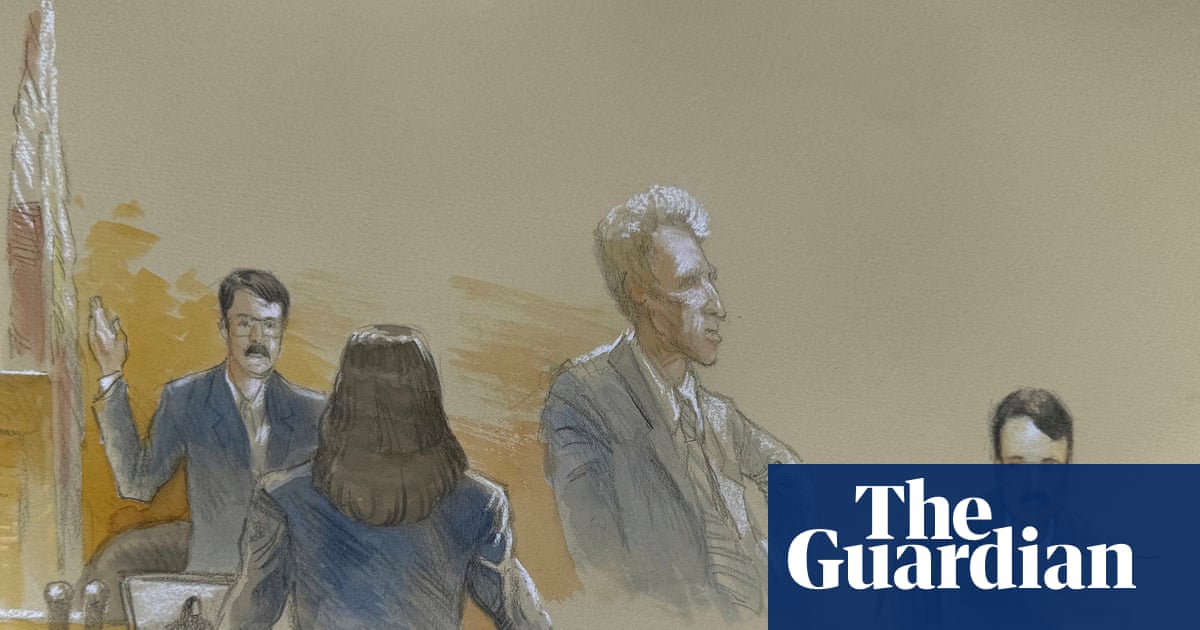On a cold winter’s night, in a “fit of spontaneity”, Nathan Dunne and his girlfriend went for a midnight swim on Hampstead Heath in London. They had been living together for a few months and, although it was dark and chilly, they “had a summer feeling in that first flush of the relationship”, Dunne says. They shed their clothes and waded into the shallows. After diving into the icy water, Dunne’s girlfriend put her lips to his cheek, and as they pulled apart, his life changed beyond all recognition. “It was like being struck. Like something came down,” he says, slicing the air with his hand. “The flip of a switch.”
Dunne’s transformation sounds like a fairytale in reverse: one kiss, and his life turned into a nightmare. Seventeen years have passed since that night, and he still mostly explains the change in himself in metaphors and similes. His eyes filled with soot. His voice was a robot’s. He felt as if he were locked outside his body, which became a sort of “second body”. Any form of water, from a raindrop to a warm bath, made everything worse. His terror and panic were so great that the next day he smashed a vase and used a shard to cut himself. An “attempt to not live any more”, is how he describes it.
It would take Dunne three-and-a-half years to learn that what he had experienced was the onset of depersonalisation disorder, a dissociative disorder believed to affect about 1.3 million people in the UK, a similar number to those with bipolar disorder, though the condition is far less known. When Dunne became ill, in 2008, the wait for a diagnosis on the NHS was thought to be between eight and 12 years. Awareness has since increased; in 2017 the MP Lyn Brown brought a constituent’s experience of depersonalisation to the attention of parliament. A charity, Unreal, was launched two years later. Now Dunne, 45, has written a book, When Nothing Feels Real: A Journey Into the Mystery Illness of Depersonalisation.

It is an eye-watering and disorienting account of a condition that Dunne evokes so vividly, it doesn’t always appear to be behind him. “Truth be told, I still have ‘second body symptoms’,” he says. “I don’t know if they will ever leave.”
Indeed, the book’s awful twist is that although researching the history of the illness felt intensely validating, and writing brought a sense of coherence to fragments of memory, it also triggered a relapse. In 2022, Dunne had a nervous breakdown. “I was not able to function in any reasonable way,” he says. “It was about as bad as it can get.” It’s fair to say that healing is very much a continuing process.
We are speaking on a video call. Dunne, who was in London studying for a PhD in art history when he fell ill, now lives in Sydney with his wife, a professor of philosophy. Last month they became parents to a baby girl. Dunne works as a freelance writer, specialising in film and art, and is sufficiently recovered that he sometimes goes for a swim. “I hope to take my daughter to the beach. Something really super-normal. That thought fills me with joy and hope for the future,” he says.
One of the greatest challenges has been the mysteriousness and unrelatability of his illness. While he knew something terrible had happened to him, he couldn’t say what. The “second body symptoms” felt impossible to convey without resorting to hyperbole and abstraction, which seemed to discredit his illness even as he described it.
Each morning, he watched himself get up, dress, make his breakfast, all from above himself – this should be taken literally, he says – looking down on the top of his own head, his foreshortened body, from within the confines of a vessel that to him resembled a waterlogged black box. He knew something of bipolar disorder, having been very troubled by a visit to a family member in a psychiatric ward. But he knew he didn’t have it, because unlike them, he says: “I had an acute sense of what was happening to me.” He kept looking at his hands for reassurance, but saw only “the hands of a ghost”.
He Googled: “Why do I feel outside my body?” “What is happening to me when I see myself from above?” “Am I going mad?” Doctor after doctor raised their eyebrows. His girlfriend despaired of him, and soon moved out.
In the weeks and months that followed, Dunne underwent many diagnostic tests including an MRI, a chest X-ray and checks on his eyesight, blood and stool samples. All came back normal. Depersonalisation is commonly misdiagnosed as depression and before long Dunne was prescribed antidepressants. Although he sensed the error, he didn’t argue. “I felt as if I needed medicine. I could take a pill and think: ‘Maybe tomorrow will be different.’”

On less symptomatic days, he continued to study, but his quest to heal himself became more desperate. He went to stay with a friend in Los Angeles and drove into the Mojave desert, looking for “a more expansive space, to try to open up this narrow view”. But he saw it all from the damp black box above his head. Some things helped briefly: listening to Dylan Thomas’ Under Milk Wood on repeat; drawing pictures of himself in the womb; making a mosaic of a Rubens painting; picking at the skin of his palms, to know where his edges were, something he found “very grounding, very physical”.
Back in London, feeling outside himself and the world, and increasingly obsessive about his ex-girlfriend, he made business cards that said “Call me”, with his phone number on. A sex worker, whose card he took down from a phone box to make space for his own, was one angry respondent. Another was a man who felt suicidal; he and Dunne spoke for hours, and afterwards, Dunne changed his phone number. In the book, he appears to do this without qualms. Alongside his self-estrangement was an intense self-absorption that often creates an empathy gap between Dunne and the reader. When, for instance, his mother told him on his birthday how wonderful it had been to carry him, he replied: “That’s not how it was for me … I was trapped.”
What is his understanding now of why he became ill? “I thought I was far more robust than I was,” he says. “I don’t think I’ve ever found life very easy.” He was born in Brisbane, Australia, and grew up in Bengaluru, India, where his parents were Protestant missionaries. “That makes for a particular kind of intensity in the family,” he says. Rather than look for a single cause of his depersonalisation, he has found it more fruitful to think of it as a buildup of traumas – “neurological, biological, and just life experience”.
Each day he wondered who he was, and whether he would ever go back to being the whole person he had been. The first big turning point came when he locked eyes with a woman at a Rodin lecture. She was in her 60s. “We didn’t fall in love in a romantic way, but it was an understanding of one another at first sight,” Dunne says. “Something about our experiences of life [made us] instantly trust each other.”
They went back to her house, and in one of the book’s most moving sequences, she asked him: “What’s your greatest fear?” “Having a bath,” Dunne replied. At this, she rose and turned on the hot tap in the bathroom, then sat in the room while he undressed and climbed in the tub. “To take off your clothes and get into a bath with an older woman you’ve just met is not a very normal thing to do,” Dunne says. “But something in her personality fostered an atmosphere where that was possible.” And something in Dunne’s illness, his foreshortened view of the world, created an openness to oddity.
A friendship grew that “helped to rebuild my capacity to love”, Dunne says. She told him: “You think of this thing you have as for ever. But I’ve lived long enough to know that there are just bad seasons in life. And then, one day … The world is new again.”
In 2011, with no money, job, or strength to study, Dunne complied with his mother’s suggestion to return home to Sydney. He moved into his parents’ garage, and she pointed out a number for a specialist she had stuck on the fridge. After a few weeks, he got a referral, and it was in this doctor’s office that Dunne was diagnosed with depersonalisation. “It was amazing when he said the word. Relief – and scepticism: ‘I can’t really hope this much, can I?’”
Dunne left the consultation with three objects: a bottle of water, a towel and a hessian bag to keep them in – an exposure and response prevention (ERP) kit. Each morning he was to dip his fingers in the water, and each afternoon wrap the wet towel around his hand. The idea being that a person who carries a small piece of their greatest fear will dilute that fear over time. “You are allowed to cry, but not to whine,” the doctor told him. “It can make you treatment-resistant.”
Dunne combined his ERP with repetitive transcranial magnetic stimulation at a private clinic – something else his mother came across – in which a magnetic coil is placed on a patient’s head so that magnetic pulses can target parts of the brain impaired by illness; in Dunne’s case, the parietal lobe, which helps to maintain a unified sense of the body. Six months later, he emerged from his parents’ garage for breakfast one morning, and told his mum: “I’m becoming myself again.”
Dunne completed his PhD, and is no longer on the specialist’s books. He continues to take medication and attend therapy. Most importantly, he knows which tools to use when symptoms recur. “When you’re looking down on yourself, I’ve been taught to speak to it. You live with it, you write with it. You help to diminish its hold over you. You accept this distorted perception, this minor confinement,” he says.

Though, in truth, more than acceptance, it is the idea of “surrender” that he has found most helpful. “Ideas of radical acceptance – I’ve tried all of those things, I can’t relate to that language. Perhaps ‘surrender’ works because it’s the last thing I want to do,” he says. “To surrender means this thing will have its way with you. When I’m in the thick of difficult symptoms, I imagine myself being steamrolled over, and being OK with that. The other word that really helped me over the years is ‘float’. The last thing I want to do is float with the second body symptoms. But the word itself, the sensation – it allows you to surrender to it, by joining it.”
He holds up his palms, flaky after all these years with picked skin. Sometimes, the wounds get so bad he has to go to the doctor. But he finds it “very pleasant to go for something ordinary”.
The emotional legacy is perhaps harder to confront. When Dunne started dating again, he worried he had “limited love” to give. He and his wife have been together for 11 years now. “I do think I am more limited than I was, and I wish that wasn’t the case,” he says. “My daughter is a week old. I wonder about how much I can give, and I hope I can give everything.
“Maybe lots of people doubt whether they can give enough to the people they love. However, I feel the illness has limited me. Like, I won’t be able to recognise when I need to give more. I have to have faith in others who have been able to do it.”
He and his wife have developed a phrase to support themselves through the hardest times. “There’s always the core us,” they tell each other. “It is,” Dunne says, “both a memory of our love and an acknowledgment of our efforts to sustain it.”
When Nothing Feels Real: A Journey Into the Mystery Illness of Depersonalisation by Nathan Dunne is published by Murdoch Books (£16.99).

 3 months ago
45
3 months ago
45

















































